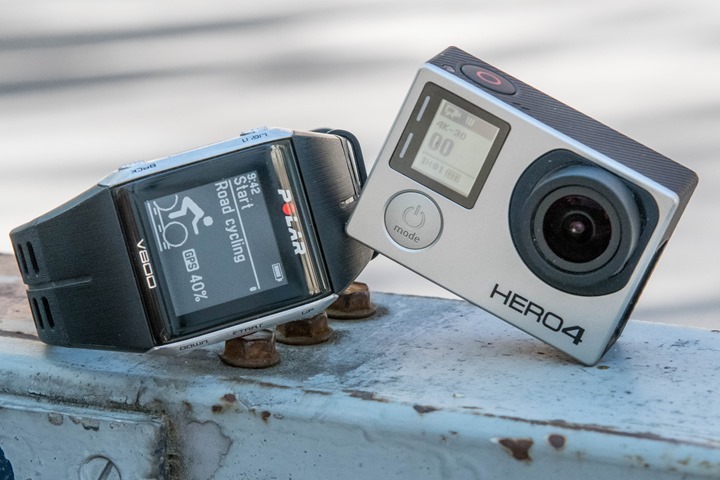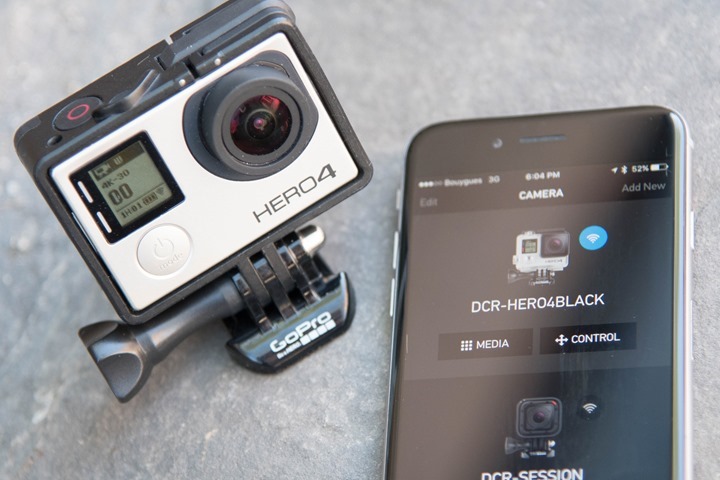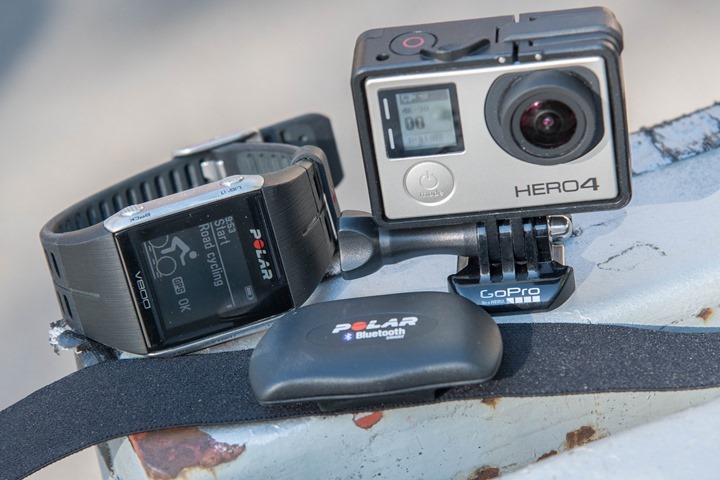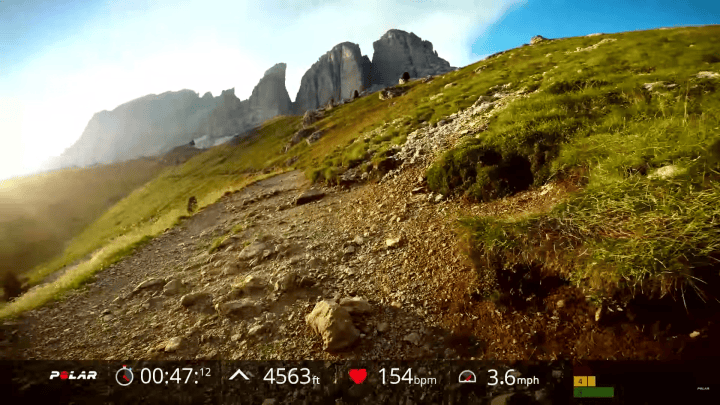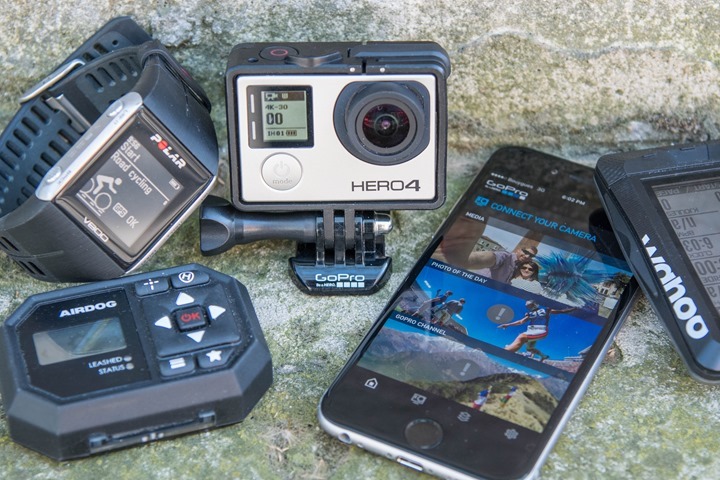It’s been a couple weeks since GoPro announced clearer details of their developer program, and in conjunction with that – when Polar concurrently announced (on GoPro’s stage) their integration of the Polar V800 with certain GoPro products.
I’ve spent the last couple weeks wrangling some answers from both sides of the equation, and now have a bit clearer picture of what the future holds. It’s actually really interesting, and even more interesting for 3rd parties beyond just GoPro and Polar.
GoPro’s new Developer Program:
Geekiness Alert: If you’re a geek, you’ll enjoy this section, if not, skip ahead to the next section.
GoPro has always had a bit of a developer interface. That interface would allow various companies to integrate directly with GoPro products. The challenge was, said interface roughly fell into three buckets:
A) Unsupported control via WiFi (many companies used this, resulted in low-quality imagery)
B) Super-secret club control via WiFi (some, like Periscope used this)
C) Physical control interface via HEROBus (such as for mounts and cases)
As you can see, sections A & B never actually were that ‘open’. It was more of an official and unofficial backdoor, but hardly something that had a landing page – let alone was oft used beyond a few special folks.
Over the past year though we started hearing more companies that claimed they were part of a new developer program. Said program was ‘exclusive’ and offered direct access to the GoPro camera for control (via various means). For example, consumer drone maker 3DR noted this (and actually implemented it), as did another drone maker AirDog (but hasn’t implemented it yet). But that still didn’t solve the problem for the masses.
Enter GoPro’s newest program, the creatively named “Developer Program”. This program sits aside two other officially named programs:
Mechanical Toolkit: This covers things like mounts and cases, basically physical interconnects
Camera Toolkit: This covers connectivity via WiFi connectivity for apps (usually on iOS/Android)
Developer Program: This has three components, covering Bluetooth Smart connectivity, HEROBus connectivity (that’s the connector on the back of the GoPro), and then metadata insertion into the video stream.
It’s this last option that now allows 3rd party entities to now control certain camera functions via Bluetooth Smart (which certain GoPro cameras have), as well as pass data to the GoPro camera to be saved alongside the video. So in effect the GoPro becomes more than just a vessel for video, but also a data recorder too.
When a 3rd party uses a feature (officially called ‘BLE Metadata Insertion’), the GoPro camera will receive the data via BLE (Bluetooth Smart) and then write it as a secondary track within the video file. This allows a 3rd party to tell the camera to record all sorts of data such as speed, distance, or even Taco Bells passed on a road-trip. Totally up to the 3rd party app. GoPro is merely a carrier pigeon for data at that point.
Once the data is recorded into the video file though, it’ll be up to the 3rd party apps to figure out how to deal with it. This means that GoPro themselves won’t read this data, nor will it even know/acknowledge it exists. Instead, you’ll defer to the other companies app (i.e. Polar) to do any video editing that takes advantage of that data. Of course, regular video editing can still be done with the native GoPro apps.
Why it matters to Polar:
For Polar, this is probably the best news it’s had in a long while in terms of gaining consumer popularity outside of endurance athletes. It gets all the benefits of an action cam, without all the headaches and cost overhead of being in that market. While action cams may have been a desirable market years ago, these days a glut of low-cost cams have put significant pricing and product pressure on many companies in the market. This way, Polar receives the end resultant of their data integration story without having to do all the work.
In the case of Polar, they’ll be using the Developer Program (and not any mechnical piece). In talking with Polar, they’ll be focused on the Hero 4 Black/Silver for now. It remains a bit fuzzy whether or not access to the Hero4 Session is even a possibility (and GoPro has been somewhat evasive on that question in my communications).
Polar’s announced integration starts with the V800, their flagship triathlon watch announced in January 2014. That watch has seen substantial software upgrades over the last few years, albeit at times somewhat slowly. This integration will effectively treat the GoPro like a data storage location. Sorta like a USB thumb drive.
So the flow of data going to the GoPro camera from the V800 includes base watch metrics like speed and distance (via GPS), but also Bluetooth Smart sensor data including heart rate (from a Bluetooth Smart HR strap). In asking Polar what other sensor data they planned to add (such as cadence or power), they noted that they’ll be starting with HR and then evaluating from there. You can see the HR data as shown on Polar’s demo video, also in the screenshot below:
Now while Polar doesn’t have to build out their own camera hardware – they will actually have to build out their own video software. That’s because the GoPro apps aren’t currently planned to be able to understand/interpret the data that Polar sends to the GoPro camera to be written alongside the video files. For that, Polar has to write their own apps.
So in effect, Polar just got into the video editing app business. This means that in order to be competitive, they’ll need to develop apps for iOS, Android, Windows, and Mac. The reason they’d need to also do desktop apps is that it’s impossible to edit higher quality GoPro (2.7K/4K) footage on all but the absolute newest of smartphones. This is not a position I’d envy.
In talking with Polar, they note that as far as platforms go they’re planning on having apps available for mobile devices, but haven’t specified which exact platforms (i.e. will they support iOS, Android, and then whether or not they’d release at the same time).
No doubt this integration is super cool for Polar users. Sure folks could use 3rd party apps like Dashware today to accomplish much of this, but the planned idea of simplicity for GoPro users on the Polar platform could be big. It could also then ripple into getting more photo/video content Polar Flow – in the same way that Suunto allows today on their Movescount platform (or like how Strava has photos in their own platform). This sort of visual content tends to draw people into a platform far more than just data stats, especially once you get beyond hardcore endurance athletes. It also helps these companies from a marketing standpoint once they see a Polar (or Garmin or whomever) logo sitting along the bottom next to the data.
Why it really matters to everyone else:
Now while I often talk about sports companies here (such as Polar), in reality this move is far larger than just Polar. Within GoPro’s developer conference, there were numerous other partnership announcements among the 30 attendee companies:
BMW M Laptimer: This extends BMW’s pre-existing GoPro integration, but adds in data metrics similar to what Garmin VIRB XE would use with an OBD-II data connector. Pulling in details such as throttle input, speed, braking and g-forces. The advantage here over an add-on solution like Garmin is simply cleaner integration straight into the car dashboard.
Timecode systems: For those doing more professional video production, one company has created a backpack system that matches up the timecodes. Super-useful in multi-camera setups (i.e. what you might have seen in Mythbusters).
Then there were companies that didn’t get announced, but are in the program. Wahoo Fitness for example, has confirmed they are in the Developer Program, with the aim of adding Wahoo ELEMNT integration with GoPro later this year.
But some of what wasn’t shown or said is potentially more interesting. For example, consider the following:
Velon: This is the umbrella group that sits over the vast majority of the pro cycling World Tour teams. Last year they partnered with GoPro to bring a bunch of Tour de France footage (among others), and that’s continued this year. Barely noticed in an article a few months back was a casual mention that they planned to add data metrics to their videos for the 2016 Tour. As such, the only way that’s going to happen is through some additional layer of sensor data capture. My guess is some small hardware layer to capture ANT+ data and re-transmit it to the GoPro’s.
4iiii: The company has quietly added functionality to their Viiiiva HR strap over the years, such as bridging and more recently gym equipment integration. In theory, there’s actually nothing stopping them from doing the same bridging with GoPro. They could in fact bridge ANT+ data via Viiiiva, and then straight into a GoPro camera. Effectively giving new life to a product as a ANT+ bridge. Of course, there are numerous other dual capable products in the market that could take this direction, such as Wahoo with their straps. But with 4iiii’s existing ANT+ to BLE functionality in place, it makes it a more natural fit.
Smartphone Apps: Excluding connecting to sensors like car engines or cycling, there’s actually a much larger audience for basics like speed and distance on videos. This could apply to skiing, windsurfing, driving, and many more. In this case, some creative developer could actually create an app on the phone that simply connects to the GoPro and adds metadata to the video stream (i.e. speed, position, etc…). For many people, having a cell phone on them is hardly a challenge (even in a waterproof case). This effectively makes the GoPro like a GPS enabled Garmin VIRB, TomTom Bandit or any number of Sony action cams.
GoPro’s challenge here though is that while the ability to use the data platform is cool, the inability to have existing GoPro apps utilize that data platform is a huge hurdle for developers. Creating a good video editing program for an action cam is the difference between an action cam company succeeding or not. In fact, GoPro’s own CEO has said numerous times in recent investor calls that their own existing app set is too hard to use for casual users. That’s been paired with a small flotilla of video app/company acquisitions by GoPro, as well as their brand new desktop editing app that’s much simpler to use.
So one has to wonder then – if the goal is to simplify the GoPro experience, why force 3rd party developers (and thus us end consumers), into more complicated scenarios? Nobody really wants to use multiple apps to edit video. And no non-video company really wants to create video editing suites on four platforms (iOS/Android/Windows/Mac). It’s a huge resource drain.
Which begs the question of when we’ll simply see GoPro’s own native apps be able to consume and display that metadata content directly within their own apps. Given that GoPro controls how that data is captured, and the data recording structures – it’s not a big leap to then display that data on videos within their apps. As in this equation, there’s nobody better positioned than GoPro themselves to make that happen.
We’ve seen that with Garmin’s VIRB Edit. Despite the Garmin VIRB camera itself being kinda clunky looking, the VIRB Edit suite (mostly on the desktop) is incredibly powerful when it comes to customization of data captured by the VIRB cameras and other Garmin products. It rarely gets enough credit for how much you can actually do behind the scenes with it. One of the key features in the VIRB Edit desktop app is the ability for consumers to create & exchange gauges and templates for data overlays.
By taking a similar tack, GoPro could empower their vast empire of millions of loyal followers to create and trade all sorts of templates, app-store style. YouTube already clearly shows how much people love their GoPro’s and the extent they go into customizing the experience around them. GoPro’s existing desktop app already supports templates, so the base framework is there.
No matter how it unfolds though, I’m definitely looking forward to having the gates finally opened up on legit GoPro integration. I think by time we hit summer, and certainly into the fall we’ll start to see some pretty cool solutions.
—
Preemptive footnote: Yes, I saw that GoPro’s upcoming Karma drone was delayed till fall (for the holiday season). While missing the summer season is a massive sales and marketing hit, I’d think that’ll probably better align their ability to sim-launch with the planned Hero5 may help. Both were noted in last week’s investor call.
FOUND THIS POST USEFUL? SUPPORT THE SITE!
Hopefully, you found this post useful. The website is really a labor of love, so please consider becoming a DC RAINMAKER Supporter. This gets you an ad-free experience, and access to our (mostly) bi-monthly behind-the-scenes video series of “Shed Talkin’”.
Support DCRainMaker - Shop on Amazon
Otherwise, perhaps consider using the below link if shopping on Amazon. As an Amazon Associate, I earn from qualifying purchases. It doesn’t cost you anything extra, but your purchases help support this website a lot. It could simply be buying toilet paper, or this pizza oven we use and love.

